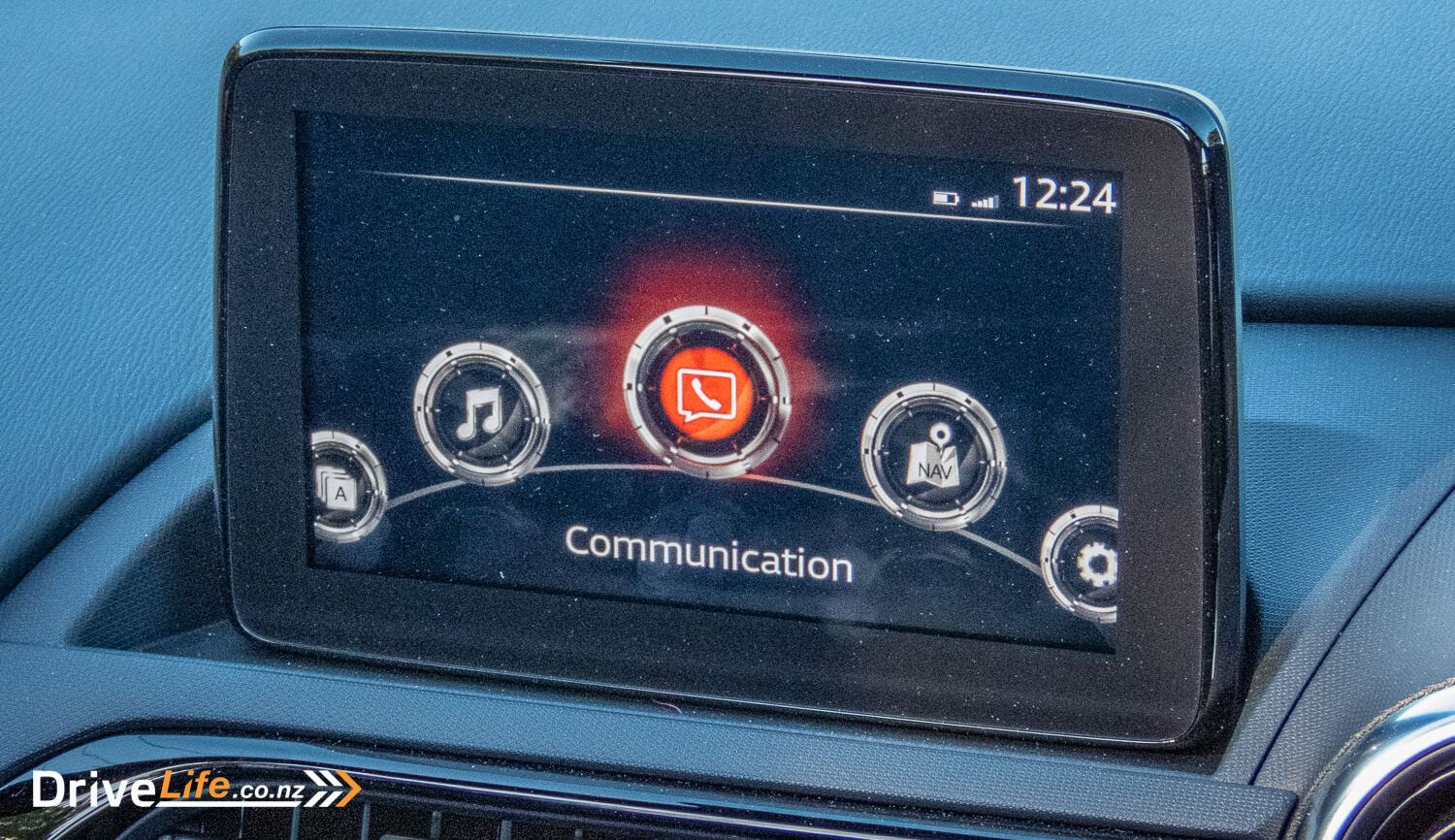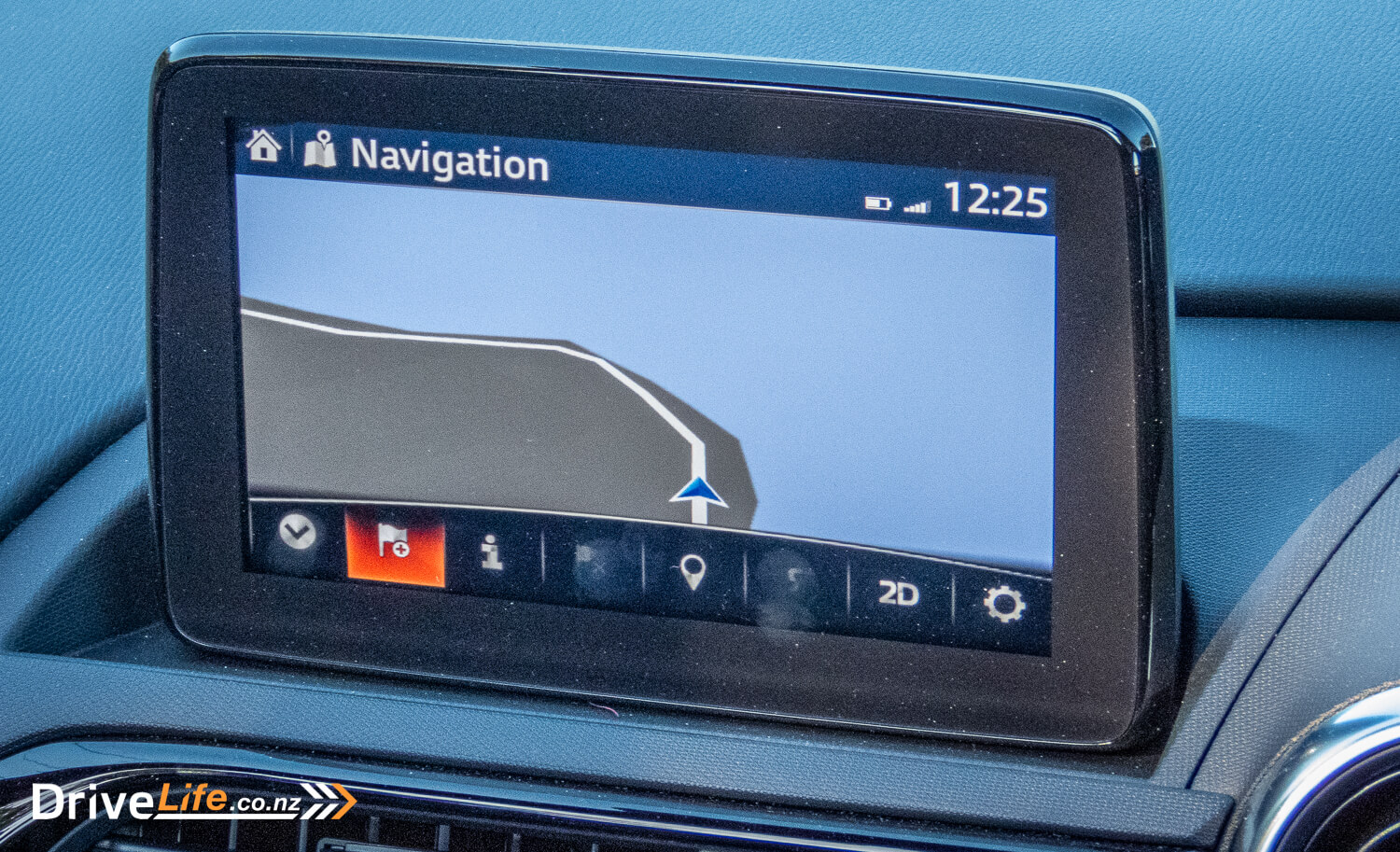In the automotive world, there are few vehicles that are as fabled as the Mazda MX-5.
If you’re reading this, chances are you already know about the MX-5’s legacy. But for the uninitiated, let’s begin with a short history. The MX-5 began production in 1989, after debuting at the Chicago Auto show. The name MX-5 was derived from the project name for the vehicle, Mazda eXperimental project number 5.
The purpose of the MX-5 was quite simple. The original MX-5 revived the concept of the small British 2-seater roadster and made it usable. It blended sharp handling, a balanced chassis, and drop-top driving into a reasonably priced package. But importantly, they made it reliable.
Unfortunately, the problem underlying many British roadsters was that they never were reliable – perhaps a hangover of the old English mentality that ‘suffering builds character’. On the other hand, the MX-5 was the roadster for those who preferred the driver’s seat over the garage creeper.
Ironically, the MX-5 perfected this British formula for America, the market where the wee roadster debuted and found the most commercial success. Regardless, the MX-5 showed the world that you can have a fun driver’s car, and it can be your only car.
As for myself, I love the MX-5. I own three currently, and have previously owned two more. Five in total! All of them are NAs.
Either way, I was pretty stoked when Mazda called up offering us the new RF for a spin. The RF is intriguing, being the first MX-5 to wear a folding Targa-top.
Importantly, is the family lineage intact? Can the RF meet the original criteria to remain true to the MX-5 formula, even with an automatic gearbox?
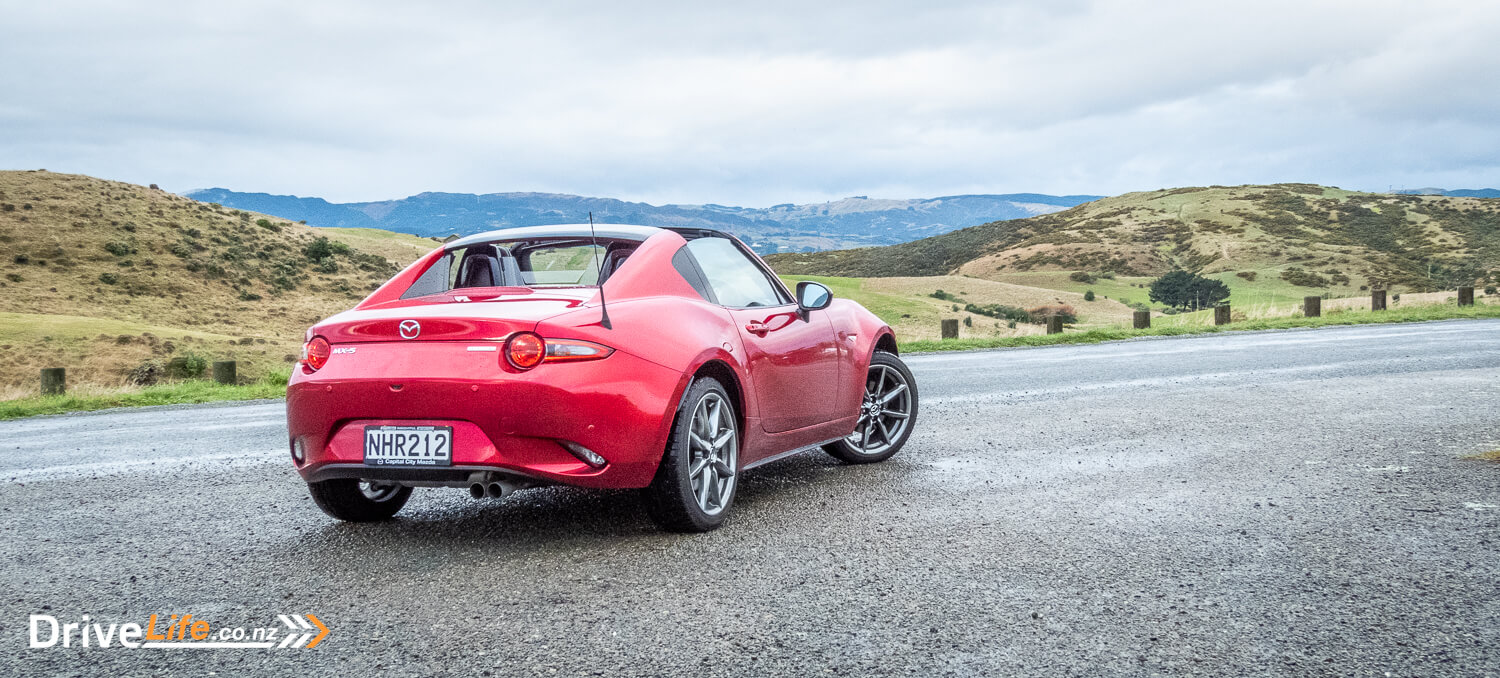
WHAT’S IN THE 2021 MAZDA MX-5 RANGE?
Before we dive into the current offerings, let’s clear up some of the MX-5’s history. I used the term “all of them NAs” in the above introduction. This is not to say that the MX-5 is naturally aspirated, because virtually all of them are (save a few special editions).
Instead, it represents the model. “NA” was the code denoting the first ever MX-5, ya know the one with pop-up headlights. “NB” was the successor, the one with fixed headlights (sad-face). “NC” succeeded the “NB”, but using the term “succeeded” might put a target on your back with certain MX-5 loyalists (personally, I like the NC). “ND” is the latest generation, which our test vehicle falls into.
Here a timeline;
NA: 1989 – 1997
NB: 1998 – 2005
NC: 2005 – 2015
ND: 2015 – now
Anyway, today’s Mazda MX-5 is known as the ND within the community.
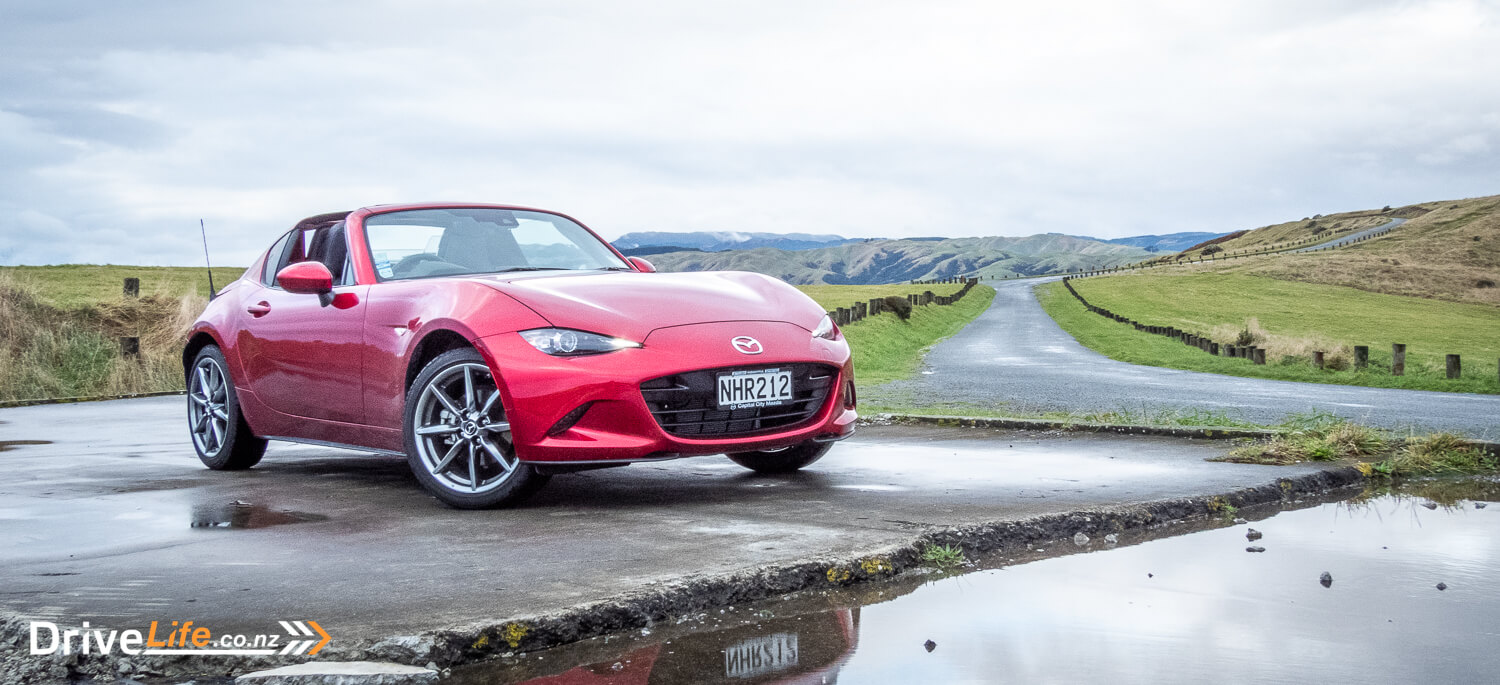
There are two ND model offerings available in New Zealand. The first of these is the MX-5 Roadster, which has the fully retractable soft top roof. The roadster starts from $49,895. The second is the RF, which has the targa-body with a folding hardtop. The RF starts from $54,395.
The MX-5 range is powered by a 2.0-litre inline 4-cylinder SV-T engine, producing 135kW of power at 7,000rpm and 205Nm of torque at 4,000rpm. The engine is paired with a 6-speed manual transmission, but a 6-speed automatic is available on the RF if optioned.
Our test vehicle is equipped with an automatic gearbox. Importantly, if you go for an automatic, you lose your limited-slip differential which is standard on cars with a manual box.
The MX-5 RF comes equipped with 17’’ alloys, a 7’’ infotainment with satnav, wireless Apple Carplay, Android Auto, a 9-speaker Bose Audio system with 203-watt amp, heated leather seats, climate control, keyless entry, rear parking sensors, auto-dimming rear-view mirror, LED headlamps with auto on/off, LED daytime running lights, heated mirrors, and body-coloured upper-door panels.
Mazda has also adorned the MX-5 with a suite of safety tech, which Mazda calls the i-Activsense safety technologies. This means the MX-5 also has forward and rear Collision Mitigation, Lane Departure Warning, Driver Attention Alert and Traffic Sign Recognition.
The MX-5 is offered with 6 different body colours; a white, a black, two greys and blue and red. The Red is Mazda’s Soul Red Crystal Metallic (which we rate highly), and is also the colour of our test vehicle.
For more information on the Mazda MX-5 range, visit Mazda New Zealand’s website.
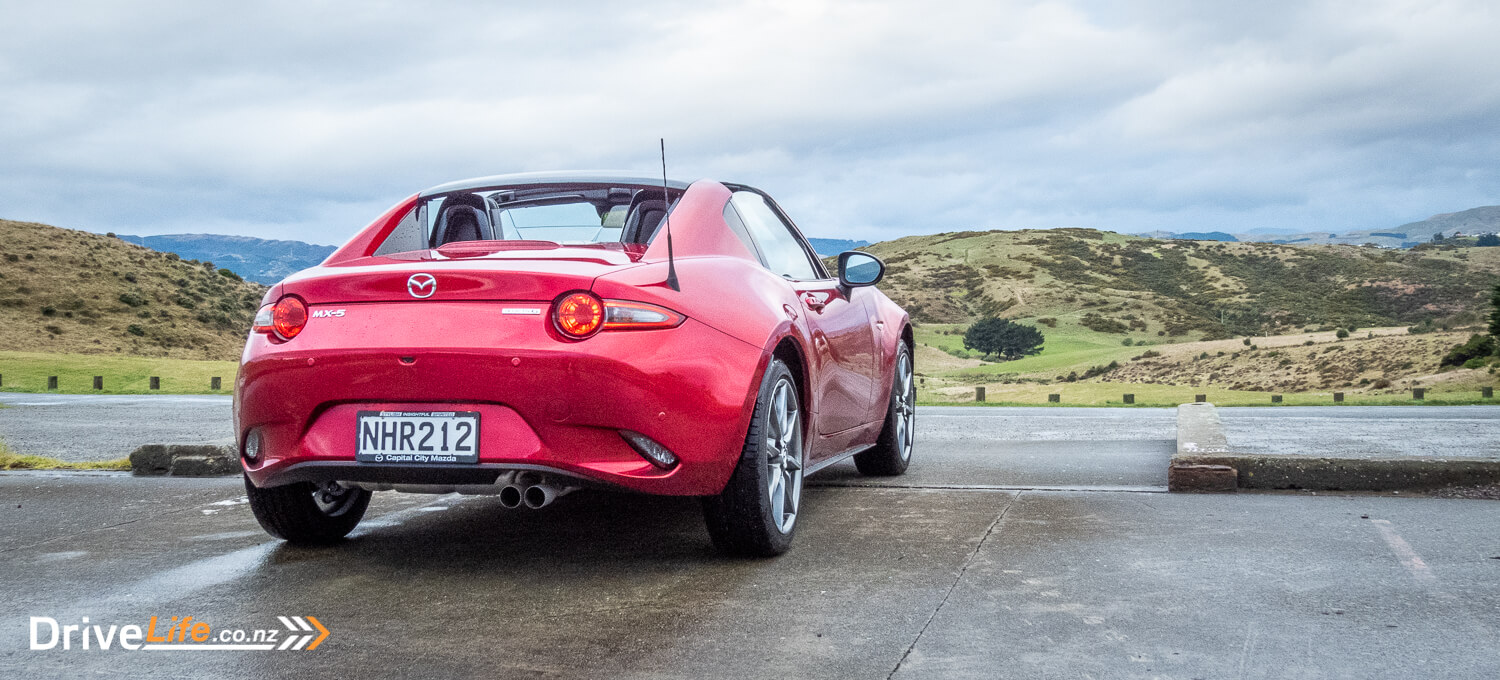
WHAT’S THE FIRST IMPRESSIONS OF THE 2021 MAZDA MX-5 RF AUTOMATIC?
The MX-5 has always had a friendly face. The original NA had soft edges, big round eyes, and a smiling grille. The cars after it shared the same qualities. It’s a cute car – even as an MX-5 owner, I can acknowledge that.
But of course, for that reason, it’s copped some flak from certain individuals. Those that generally aren’t comfortable with themselves liking something deemed “feminine”. In my experience, they tend to share a liking of lifted 2WD utes, bourbon and cola, and baseline cigarettes.
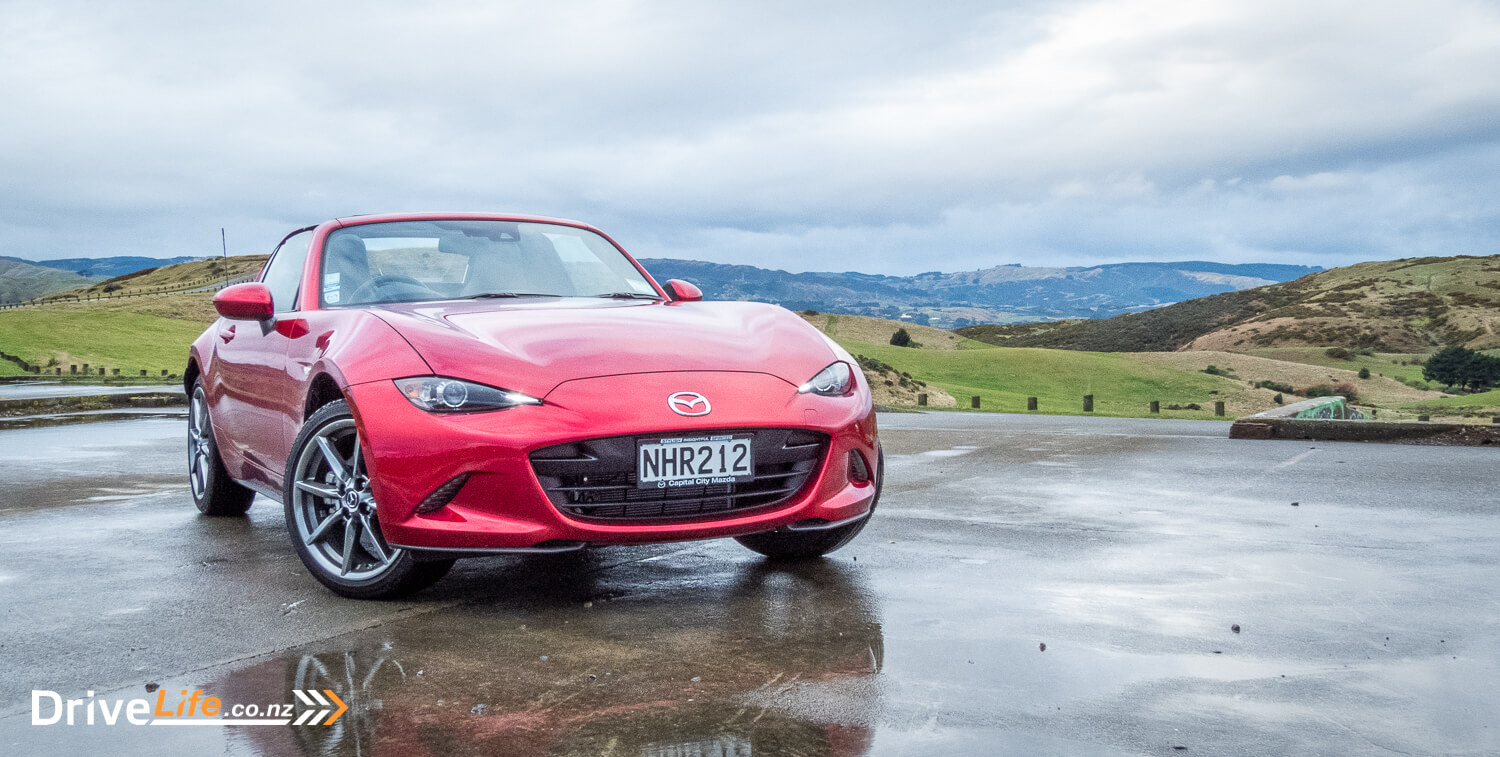
The ND, on the other hand, is perhaps the most muscular MX-5 produced by Mazda, and that’s saying something. The front has squintier, angrier headlights and the side arches are flared, showing-off whatever muscles it has. However, Mazda hasn’t gone overboard – you can still tell the car is smiling, if a little more grown up this time.
Move towards the back of the MX-5 the angles do become more feminine, with rounded edges and rear taillights which sort of look like they’ve got eyelashes.
As differences between models go, the RF’s targa-top doesn’t overly interfere with the lines of the roadster. Mazda’s integrated it rather nicely, even if I still prefer the overall look of the roadster.
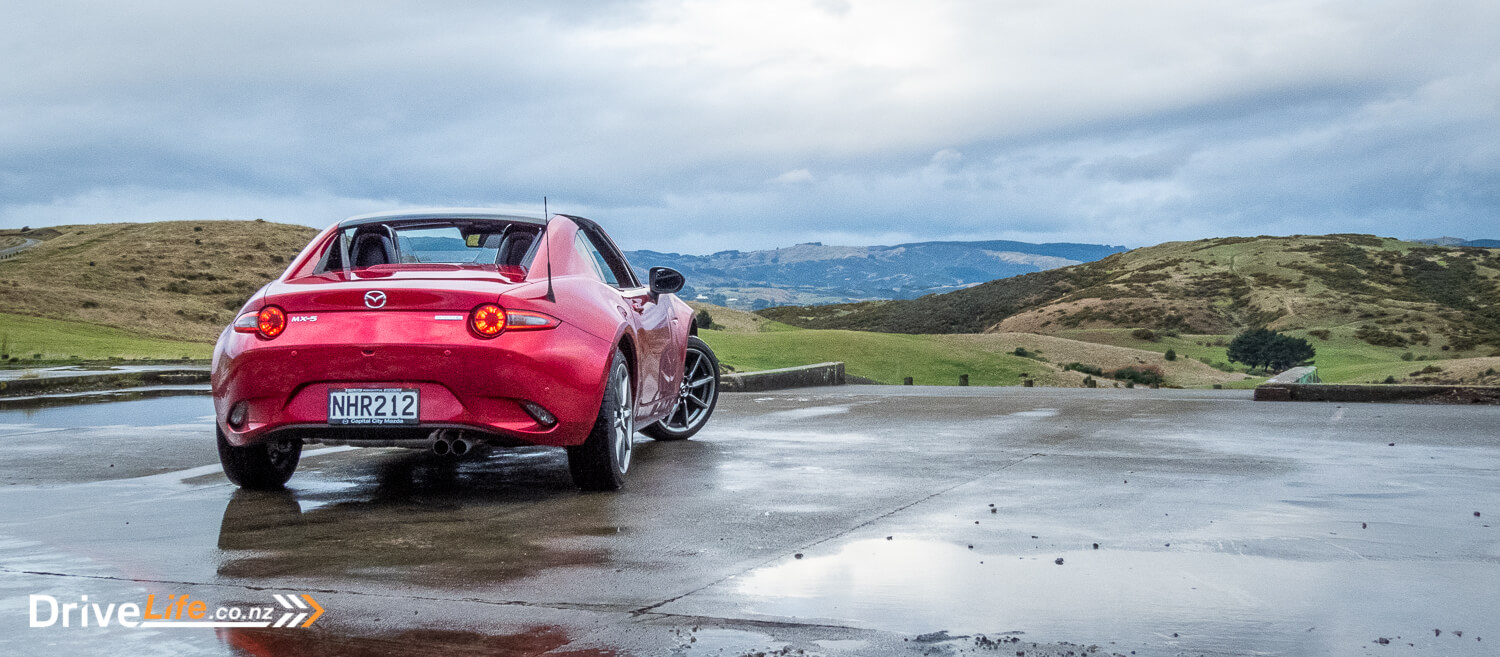
WHAT’S THE INTERIOR LIKE ON THE 2021 MAZDA MX-5 RF AUTOMATIC?
Given the sort of car this is, size expectations should naturally be tempered before climbing in. It’s a two-seater sports car, afterall.
That said, this generation of MX-5 is a pokey vehicle, even as someone who is used to driving roadsters.
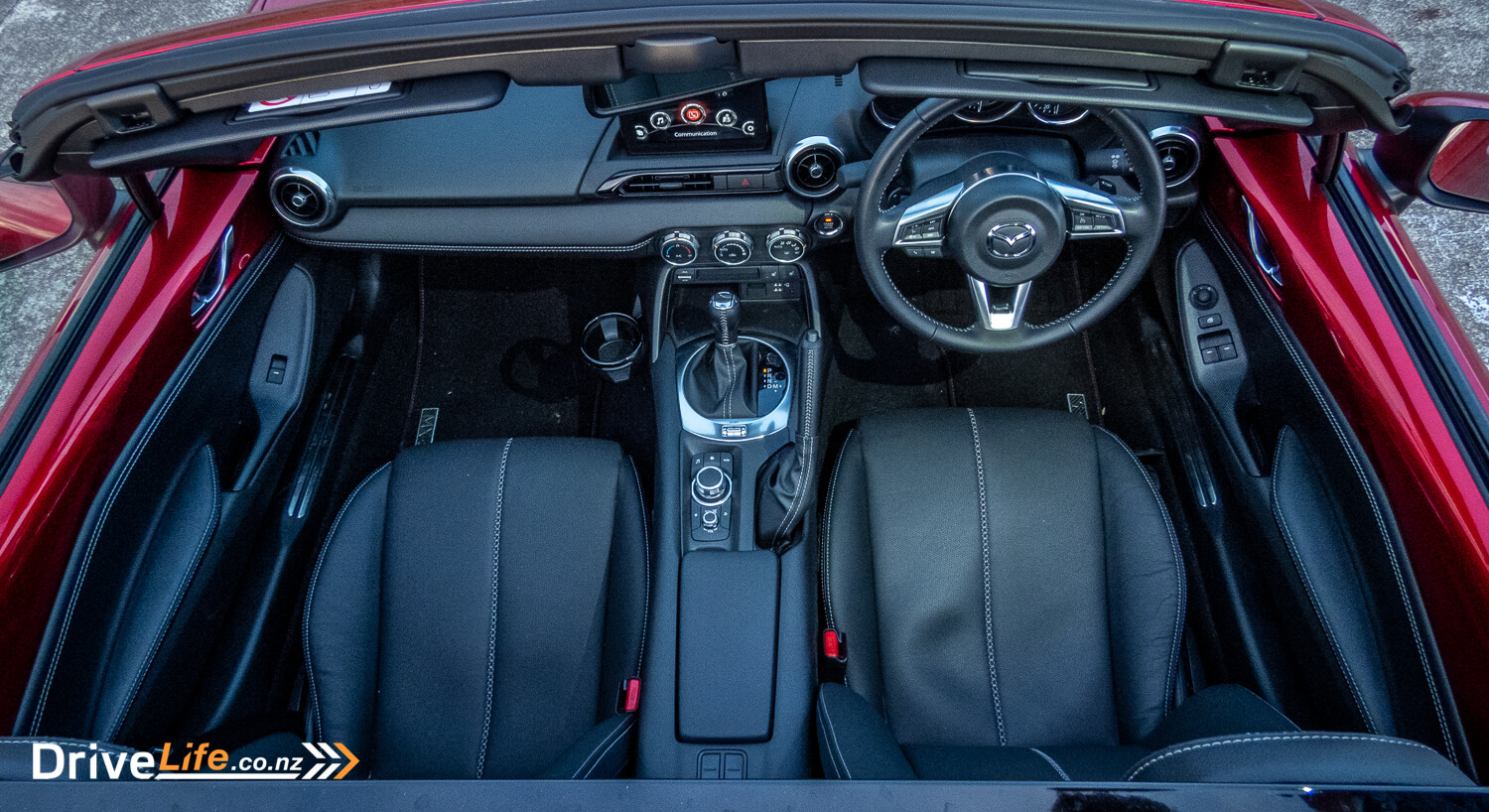
The cabin is definitely a snug place for the driver. Although I did manage to get comfortable, I was definitely using all surplus space to achieve it. My hair skimming against the roof confirmed this. The passenger’s footwell is also smaller than the driver’s, largely due to the space occupied by the transmission.
So, the MX-5 is not a tall-people car, but the original wasn’t exactly that either.

Another issue is storage, specifically there’s no glove box nor a dedicated place to stash your wallet and phone. There’s a small storage cubby on the centre console, but aside from loose items like coins and pens, I cannot see the use for it. The centre storage bin is the only suitable place for valuables, but it’s a pain to access while driving. There’s two further storage bins behind the driver and passenger, but you need to move the seats forward to access them.
I ended up using the removable cup holders to stash my phone. These cupholders are a bit of genius from Mazda – they can be mounted just in front of the centre storage bin, or can be clipped into a slot down near the driver and passenger’s knee.

However, the issues stop there. Most will find the MX-5’s interior to be a generally pleasant and well-designed space.
The build quality of Mazda’s line-up has been exceptional as of late, and the MX-5 is no exception. The majority of the interior is made up with robust hard plastics, but none of them feel cheap. The touch points are all high quality, with some softer materials wrapping surfaces like the steering wheel, plus many of the buttons and switchgear are nicely dampened.
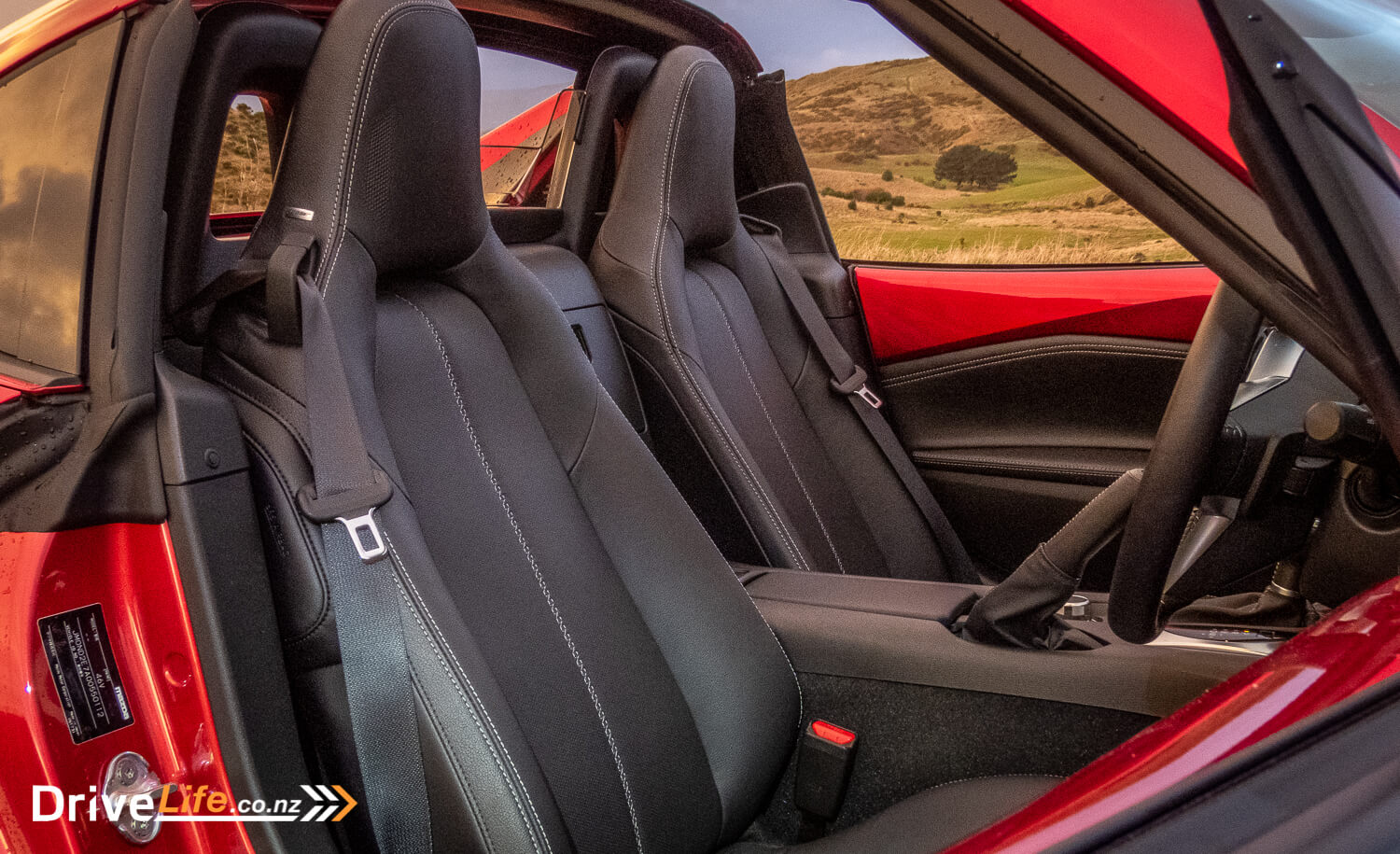
The seats have a thin to medium profile, meaning that anyone with wider shoulders will feel the bolstering. They’re also quite scalloped out in the seat base, presumably to get the driver lower down into the seat for those crucial headroom inches. Otherwise, the seats are fairly comfortable for daily driving.
I also greatly appreciated the heated seats; every modern convertible deserves them. Even though we were testing the car in winter, the heated seats kept you toasty enough to have the roof down in colder temperatures, if one is so inclined.
Tacked onto the top of the dashboard is a 7’’ inch infotainment unit. The infotainment doesn’t use Mazda’s latest interface, which is found in the Mazda3 and CX-30, but instead uses the older version still found in the CX-5 and others. This isn’t exactly a major drawback as the slightly older software still responds well, has a friendly interface and good resolution. Granted, the newer system is more elegant than the old one.
The 9-speaker Bose stereo and amp package in the MX-5 is truly excellent. The system can really pump-out some volume with losing any major fidelity, which is perfect for roof-down driving.
I also never had any issues hearing or speaking on phone calls via Bluetooth with the roof down either. This is helped by the speakers built into the head-rest, directly behind the driver’s ears. Of course, this isn’t anything new for Mazda – my NA’s have headrest speakers too – but in terms of quality, the difference is night and day.

Boot space will naturally be small in a roadster, but I must give Mazda some credit for laying out the space well. The boot space is a relatively reasonable-sized oval shape, with a wide vertical opening and reasonable depth, meaning there’s enough space for an over-packed weekend bag. The boot is also a dedicated space, meaning the targa roof isn’t going to collapse back into there and squash your groceries.
The most annoying part of the boot is actually opening it. I couldn’t locate any interior button to pop it open, meaning you needed to use the key fob or the exterior button located down below the number plate. Also, the button on the key fob will not work unless the car is switched off. This is a quality you can get used to, but I can guarantee your passengers will never figure it out.
WHAT’S THE 2021 MAZDA MX-5 RF AUTOMATIC LIKE TO DRIVE?
Shall we start under the hood? Sure, but the MX-5 has never been about the numbers. So why start here?
Well, take a look at the engine. Look at it!
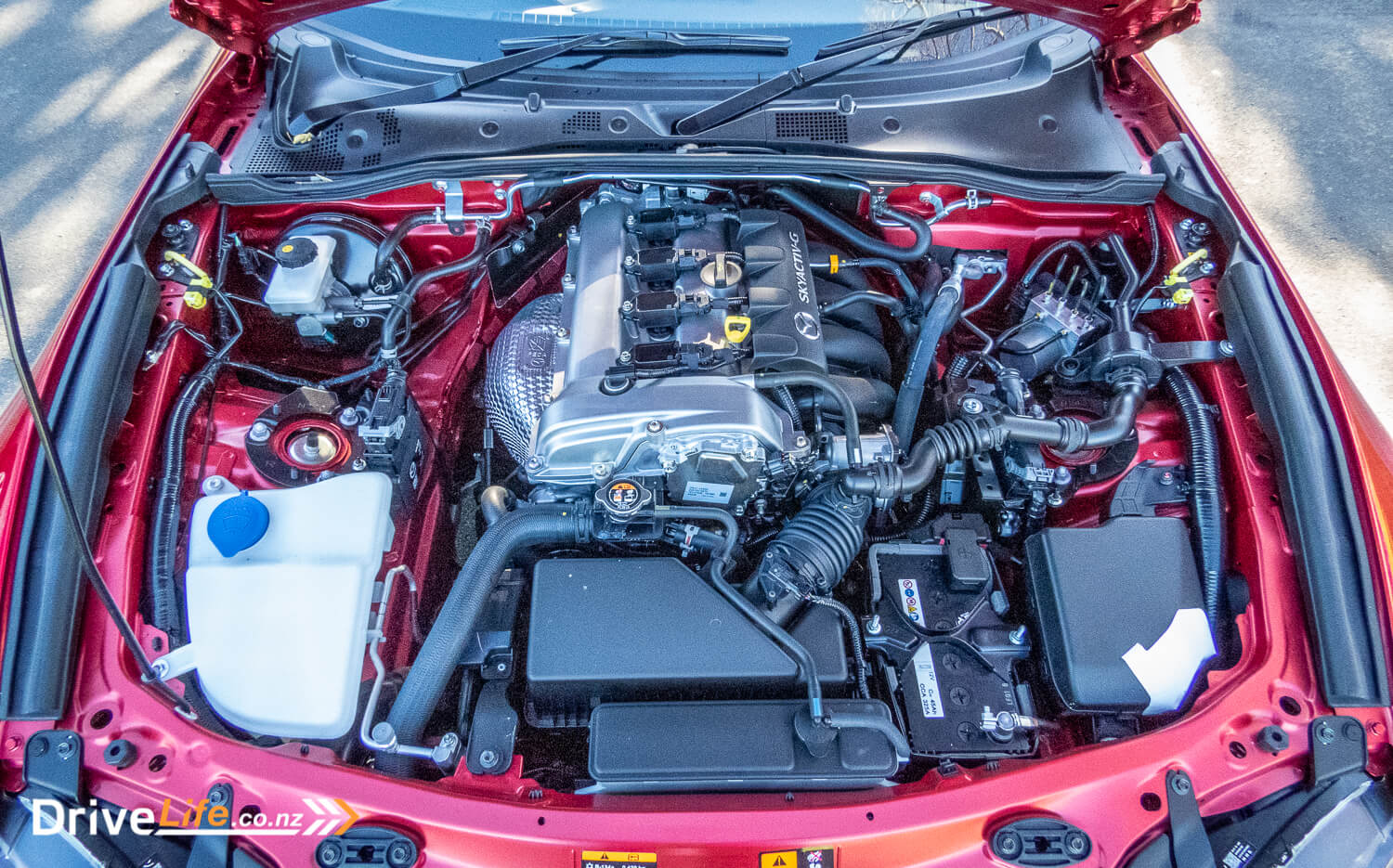
There’s no pipes, rogue lines or any other plastic nonsense cluttering the engine bay. It’s just a clean metal valve cover and coils on top, which is sorta reminiscent of the same valve cover on the first MX-5.
In a time where some of the best performance cars are hiding their engines, the MX-5’s shameless display is so refreshing.
To me, a clean engine bay is good engineering, and to me, it embodies the personality of the MX-5. Afterall, the MX-5 was designed to be an accessible way for all keen motorists to enjoy the mechanical precision and finesse of a light and balanced sports car. It was well-engineered, but also mechanically simple.
But don’t think that I’m getting carried away because of a tidy engine bay. To further my point, we need to look under the car, specifically at the suspension. There’s aluminium double wishbone control arms, with camber and toe adjustment. There’s more aluminium for the cross bracing too.
The abundance of aluminium shows Mazda’s commitment to lightness, even in an era where vehicles are naturally heavier due safety regulations and from all of the tech apparatus on-board.
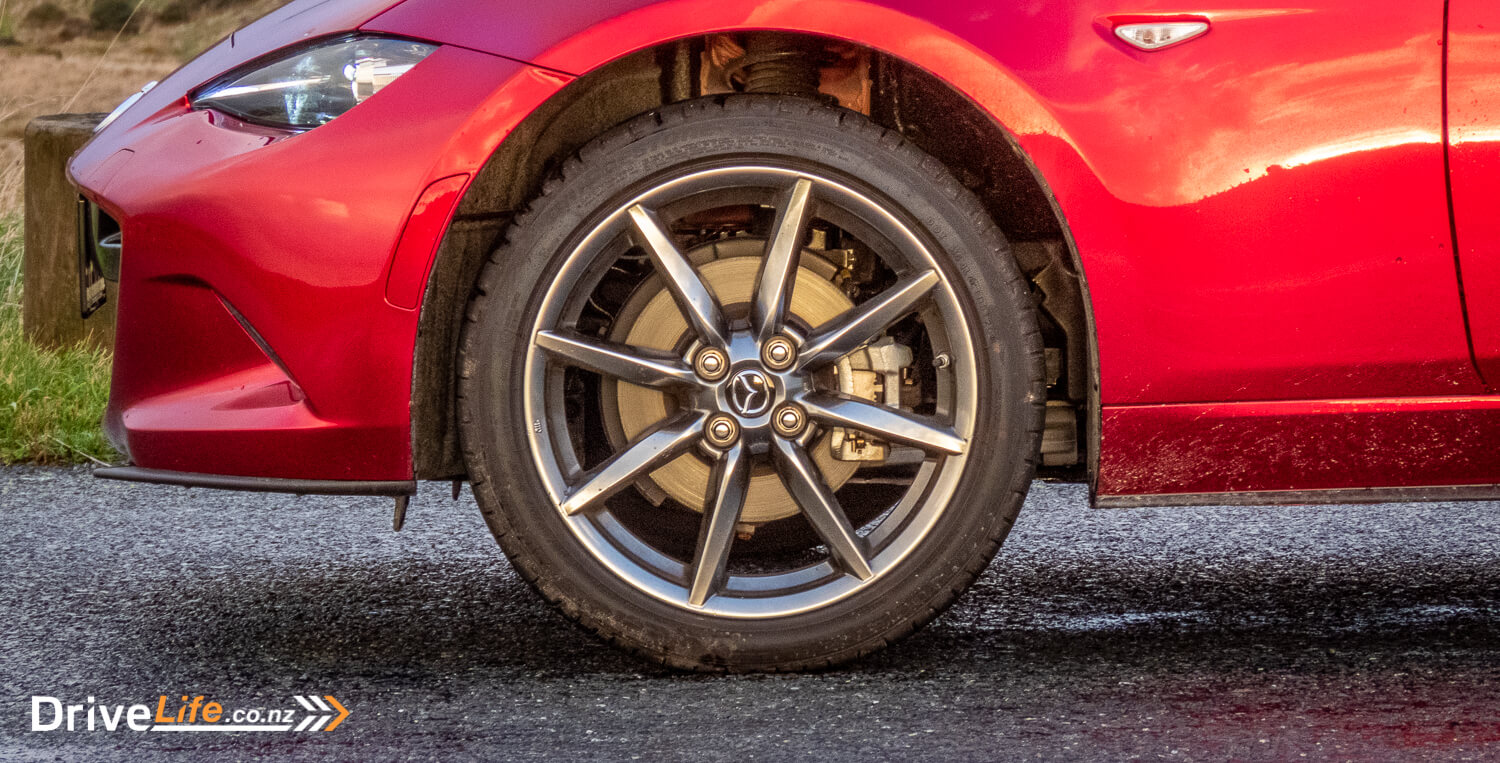
Shifting focus back to the engine, the MX-5 is powered by a 2-litre 4-cylinder Skyactiv-G engine producing 135kW of power and 205Nm of torque. These figures are a small boost for the ND for models produced from 2019 onwards.
Earlier ND models were first released with two engine options; a 1.5-litre 4-cylinder, which put out a meagre 96kW and 150Nm, and a 2-litre 4-cylinder which put out a healthier 118kW and 200Nm of torque. The 2-litre was the obvious pick of the bunch, as the 1.5 litre was just a tad too underpowered, even when carrying such a light frame.
So, does the extra power make a difference? Yes – but mainly for when you’re already moving. The extra power comes out in the mid-to-top range, which gives the MX-5 an exceptionally linear power curve and compliments the decent torque figure.
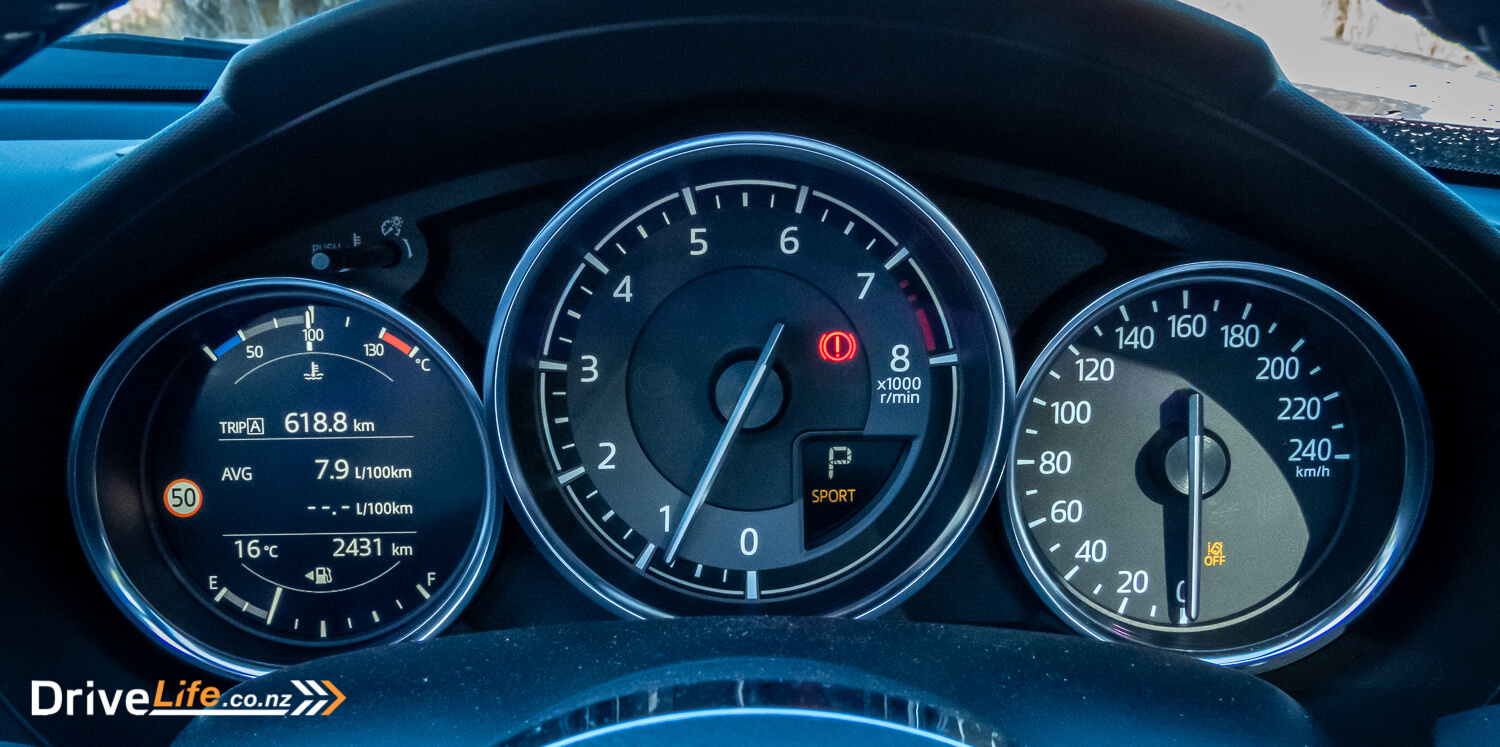
In the real world, one of the real strengths of the MX-5 is simply doing the commute. The healthy torque figure means there’s decent off-the-line pull, and the engine revs freely through the mid-range. Traditionally, MX-5’s didn’t have this initial shove, so driving one needed more throttle input to get it onto the desirable part of the power curve.
Despite the extra performance, it doesn’t fundamentally alter the character, nor the style of driving the MX-5 does best. In other words, the MX-5 is the epitome of slow-car fast.
Slow-car fast means you can plant the right pedal, rev to the red-line and wring the engine of every bit of power, without losing your licence or wrapping your car around a tree.
The MX-5 encourages momentum driving, rewarding the driver for hitting the correct lines, being in the right gear to stay within the powerband, and maintaining all of your velocity from corner entry to exit. Momentum driving requires skill and finesse, but is immensely rewarding. Get it right, and you’ll feel like a driving god. For me, it’s one of the best driving sensations anyone can experience.
Which brings us to a contentious point with our press-car – it’s an automatic.
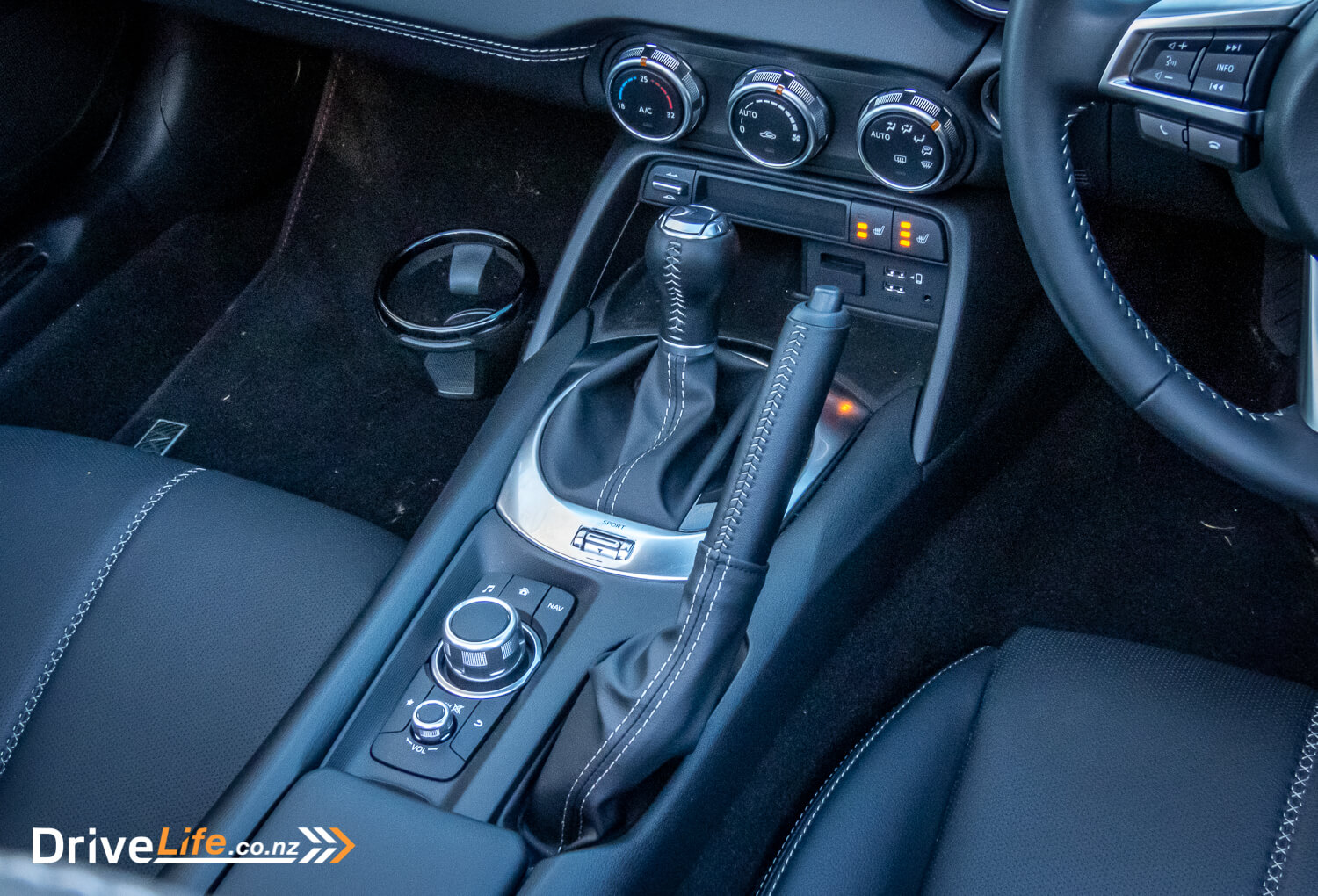
For many, the automatic will be the choice of those interested in open-top cruising, which this 2021 model does surprisingly well, given its healthy torque output in a light frame. For myself, I wasn’t a huge fan of the automatic, mainly because it peels away a layer from the experience. Focusing on the automatic box, it had a tendency to hunt gears at suburban speeds. Granted, it was pretty decisive once you put it into manual mode and used the paddle shifters.
I have driven a manual variant, and it is excellent. The box has a short throw and a nice notched feel to it. It’s easily one of the best manuals available in a new car – but sadly, there’s not a whole lot of competition in this space anymore. Overall, it will still impress most manual gearbox connoisseurs.
So, how does the RF perform relatively speaking? Well, the RF is 49kg heavier than the roadster, or 76kg heavier with the automatic. Do you notice? Hardly.
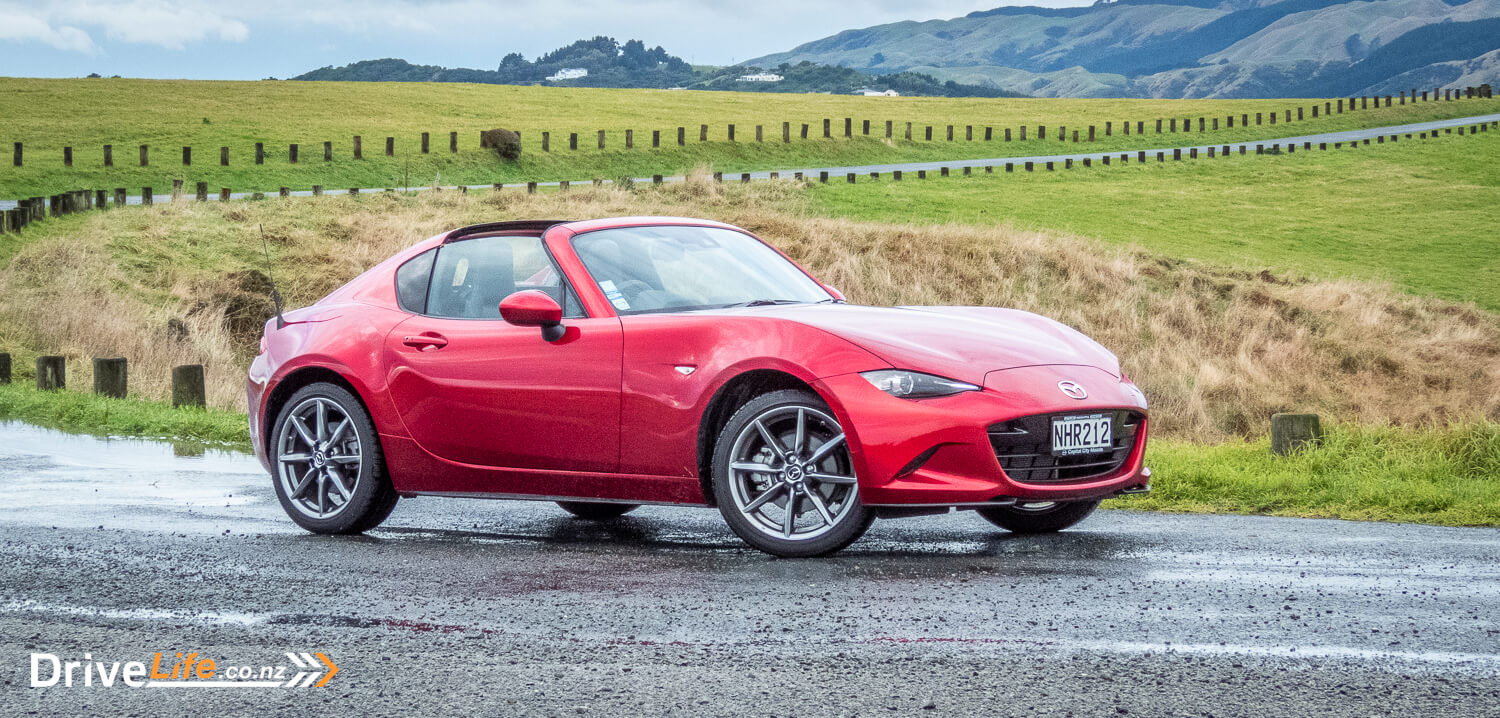
The RF still manages a near 50/50 weight distribution, and most of that extra weight is over the rear wheels. Combine the excellent chassis, steering and a low centre of gravity, the MX-5 RF is a hoot to drive on a twisty road.
When moving quicker, the ND feels much more hunkered down relative to older MX-5 models. Compared to the older cars, it doesn’t feel as light on its feet, nor does the rear doesn’t scamper about like the NA, but the sure-footedness means you’ve got the confidence to safely push the boundaries.
Although it’s a slightly different experience for anyone who is considering upgrading from an older car, it’s still great fun. Much like MX-5’s of old, the chassis does introduce some body roll when you’re really gunning it, but it doesn’t actually let go until unless you’re being a real wally.
This mightn’t sound great, but consider the bigger picture. The MX-5 isn’t a serious, hard-edged race car. It’s designed for silliness at sensible speeds and the chassis feedback makes it more fun within those boundaries.
It’s also a good feedback mechanism for those with less experience, as the car gives you as much warning as possible before it’ll finally send you into a ditch. Of course, that never seemed to deter some drivers, meaning spotting older cars on the road is a relatively rare sight these days.
Opting for the automatic RF deletes the limited slip differential, which becomes a problem if you’re really giving it the beans. 90% of the time, many will be ambivalent about this. But, on a few test-runs over the ‘takas, I found myself wanting it. The brakes aren’t exactly anything to write home about either, but they never were on the old cars either.
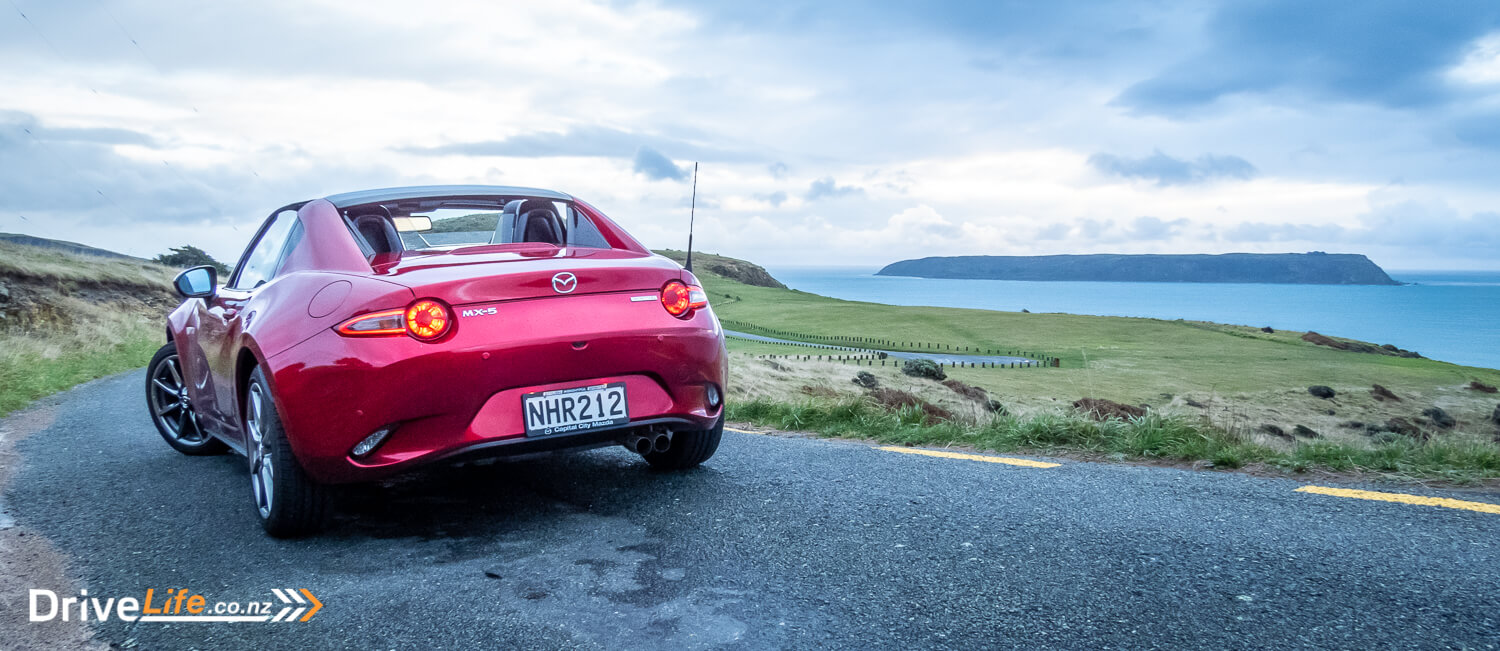
So, are there any major advantages to having the hardtop? Aside from the obvious fact that it’s more durable, the RF offers quite a different experience to the roadster. The RF is more cocooned, feeling more like a coupe. It has less of the wind-in the hair feeling from the roadster. As a sensory experience, the RF just feels a bit more muted without that.
Granted, the RF is eminently more daily-able because of the hard-top. It’s quieter without the harshness and noise generated from the rag-top. Even though we had this car on test in the middle of winter, keep the heated seat on, you could drive it top-down in some fairly anti-social temperatures. Otherwise, the downsides are mainly limited to some cabin buffeting with the roof down (which you won’t escape with the roadster), and those large buttresses do introduce a fairly sizable blindspot.
Although, I cannot shake the feeling that the RF would only deliver a 9/10 experience relative to the roadster on a cracking summer’s day, which is ultimately your trade-off between the two cars. Of course, if you’re not inclined to wait for the weather to improve, the RF is a good option, and probably the better option for Wellingtonians.
Finally, and to address the real question for many MX-5 owners, do other MX-5 owners’ wave at you in the RF? I saw two MX-5’s in the wild during my test with this car. One of them waved – that’s a pass in my book.
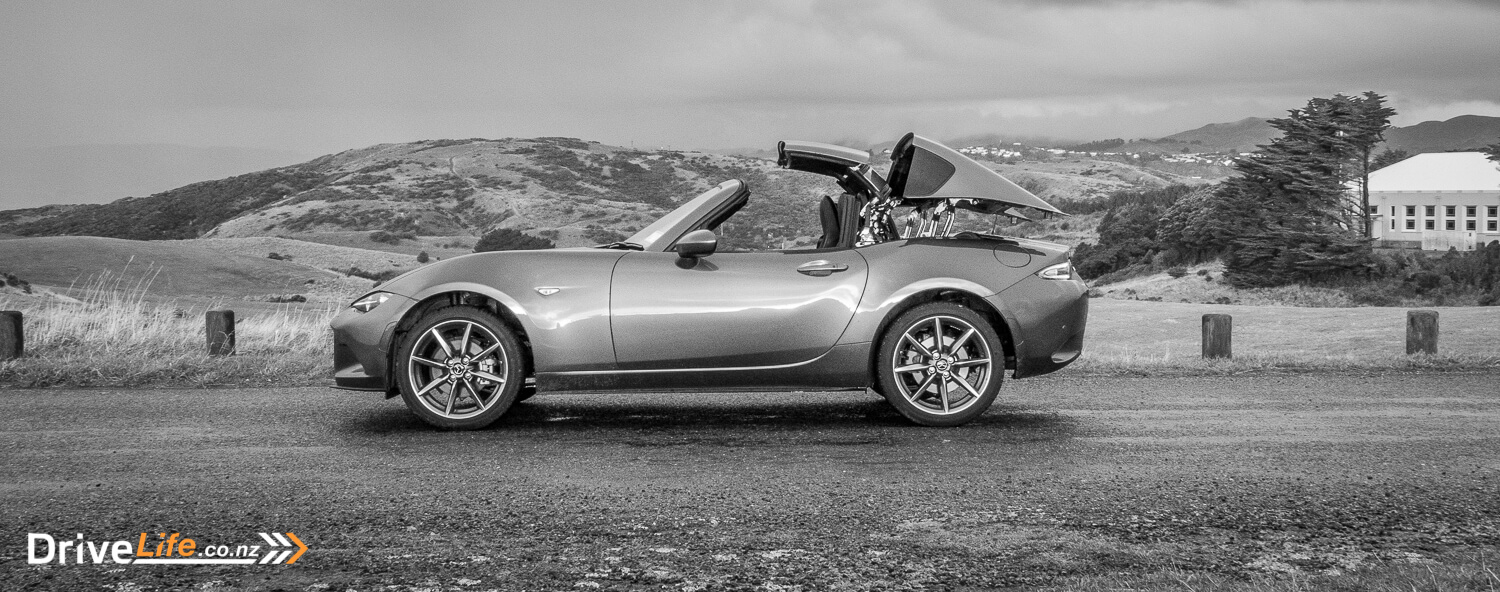
WHAT’S THE COMPETITION FOR THE 2021 MAZDA MX-5 RF AUTOMATIC?
There’s no competition for the MX-5 in today’s market, which sadly underscores the fact that this MX-5 is one of the last of its kind. The Toyota GT-86 is no longer for sale, nor is the MX-5’s sister car, the Abarth 124 Spider. However, there is a glimmer of hope, which is Toyota’s anticipated GR-86, but that’s not here yet, nor is it a convertible.
| Brand/Model | Engine | Power (kW)/Torque (Nm) | 0-100 kph (seconds) | Fuel, L/100km (claimed) | Price |
| Mazda MX-5 RF | 2-litre 4-cylinder Petrol | 135/205 | N/A | 7.2 | $54,395 |
WHAT’S THE PROS AND CONS OF THE 2021 MAZDA MX-5 RF AUTOMATIC?
Pros
- Excellent chassis
- Handling
- Extra oomph for 2021
- Fuel Economy
- Performance for dollars
- Hard-top practicality
- Great Bose stereo
- Smiles per gallon
Cons
- Tight cabin
- Awkward interior storage
- Large blindspot
- Needs a decent exhaust note
- Automatic gearbox doesn’t do it for me
- No Limited slip diff with an Automatic
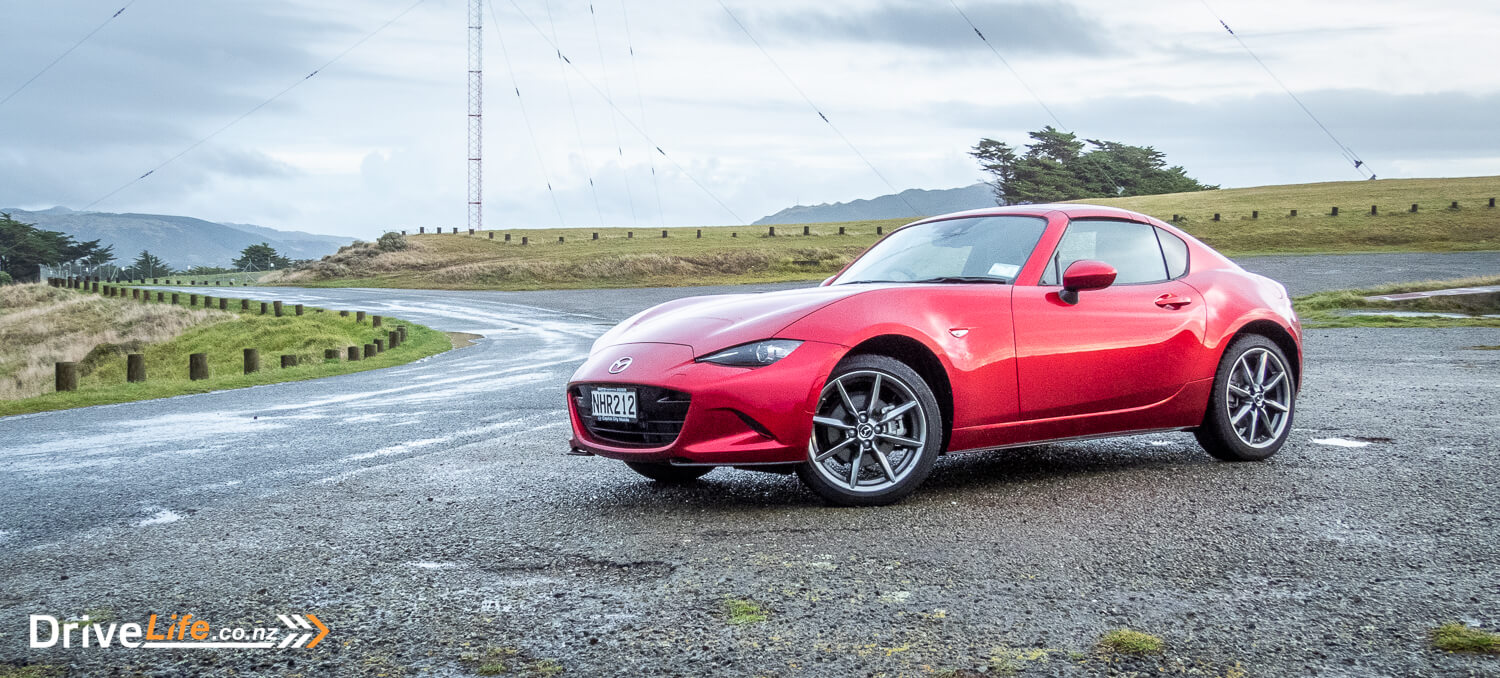
2021 MAZDA MX-5 RF AUTOMATIC – SPECIFICATIONS
| Vehicle Type | 2-door, 2-seat retractable-hardtop sports car |
| Starting Price | $54,395 |
| Price as Tested | $54,395 |
| Engine | 2-litre, 4-cylinder petrol |
| Transmission | 6-speed automatic |
| Power, TorquekW/Nm | 135/205 |
| Spare Wheel | Space saver |
| Kerb Weight, Kg | 1,134 |
| Length x Width x Height, mm | 3915x1735x1235 |
| Cargo Capacity, litres | 127 |
| Fuel Economy, L/100km | Advertised Spec – combined – 7.2 Real World Test – combined – 7.9 Low Usage: 0-6 / Medium Usage 6-12 / High Usage 12+ |
| Fuel tank capacity, litres | 45 |
| Towing Capacity Kg, unbraked/braked | N/A |
| Turning circle, metres | 9.4 Small: 6-10m / Medium 10-12m / Large 12m+ |
| Warranty | 5 years Mazdacare warranty unlimited km 5 years Roadside Assistance unlimited km Mazda Servicing for 3 years/100,000km |
| ANCAP Safety Ratings | 5 Star |


